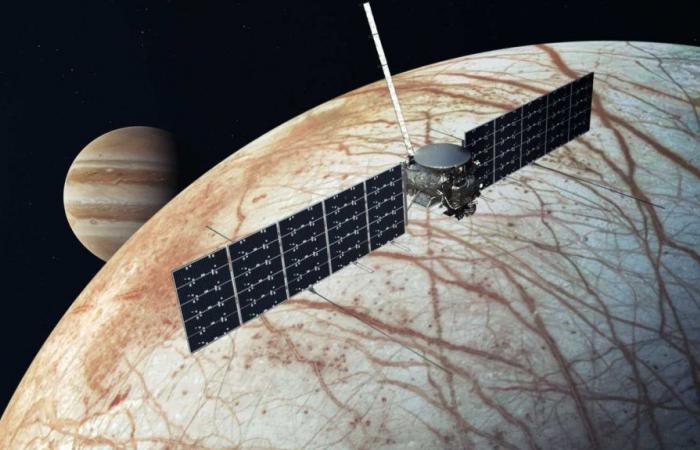A NASA spacecraft is set to set course for Jupiter and its moon Europa, one of the best ways to find life beyond Earth.
“Europa Clipper” will peer beneath the moon’s icy crust, where an ocean is thought to flow quite close to the surface. He will not seek life, but rather determine whether conditions could support it.
“This is a chance for us to explore not a world that could have been habitable billions of years ago, but a world that could be habitable today, right now,” said the scientist from the Curt Niebur program.
Its massive solar panels make “Clipper” the largest spacecraft built by NASA to study another planet. It will take 5 1/2 years to reach Jupiter and will sneak within 25 kilometers of Europa’s surface, considerably closer than any other spacecraft.
Liftoff is scheduled for this month aboard SpaceX’s “Falcon Heavy” rocket from NASA’s Kennedy Space Center. The cost of the mission is $5.2 billion.
Europa, one of Jupiter’s 95 known moons, is almost the size of our own Moon. It is embedded in an ice cap whose thickness is estimated between 15 and 24 kilometers. Scientists believe this icy crust hides an ocean that could be 120 kilometers deep or deeper. The Hubble Space Telescope has spotted what appear to be geysers erupting from the surface. Discovered by Galileo in 1610, Europa is one of the four Galilean moons of Jupiter, along with Ganymede, Io and Callisto.
What type of life could Europe be home to? Besides water, organic compounds are necessary for life as we know it, as well as a source of energy. In the case of Europa, these could be thermal vents on the ocean floor. Bonnie Buratti, deputy project scientist, imagines that all life would be primitive, like the bacterial life that originated in Earth’s deep ocean vents.
“We won’t know from this mission, because we can’t see that deep,” she said. Unlike missions to Mars, where habitability is one of many questions, “Clipper’s” sole mission is to determine whether the moon could support life in its ocean or possibly in pockets of water in the ice.
An oversized spaceship
When its solar wings and antennas are extended, “Clipper” is about the size of a basketball court (more than 30 meters from end to end) and weighs nearly six tons. The oversized solar panels are necessary because of Jupiter’s distance from the sun. The main body (about the size of a motor home) is equipped with nine scientific instruments, including radar that will penetrate ice, cameras that will map virtually the entire moon, and tools to extract content from the surface and atmosphere tenuous of Europe. The name refers to the fast sailing ships of past centuries.
The round trip to Jupiter will span 3 billion kilometers. For added dynamism, the spacecraft will pass by Mars early next year, then by Earth at the end of 2026. It will arrive at Jupiter in 2030 and begin its scientific work the following year. In orbit around Jupiter, it will cross Europa 49 times. The mission will end in 2034 with a planned crash on Ganymede, the largest moon of Jupiter and also that of the solar system.
There is more radiation around Jupiter than anywhere else in our solar system except around the sun. Europa passes through Jupiter’s radiation bands as it orbits the gas giant, making it particularly threatening to spacecraft. This is why the electronics of “Clipper” are located inside a vault with dense walls made of aluminum and zinc. All this radiation would wipe out all life on the surface of Europa. But they could break down water molecules and, perhaps, release oxygen back to the ocean, which could eventually fuel marine life.
Earlier this year, NASA was panicked that the spacecraft’s many transistors wouldn’t be able to withstand the intense radiation. But after months of analysis, engineers concluded that the mission could go as planned.
NASA’s sister Pioneer spacecraft, and then two Voyagers, flew by Jupiter in the 1970s. The Voyagers provided the first detailed photos of Europa, but from quite a distance. NASA’s “Galileo” spacecraft flew past the moon several times during the 1990s, passing within 200 kilometers. Still in action around Jupiter, NASA’s “Juno” spacecraft added photos to Europa’s album. A year after “Clipper”, the European Space Agency’s Juice spacecraft, launched last year, will arrive on Jupiter.
Like Europa, Ganymede, Jupiter’s giant moon, is believed to be home to an underground ocean. But its frozen shell is much thicker – possibly 100 miles thick – making it more difficult to explore the environment underneath. The Callisto ice sheet could be even thicker, perhaps hiding an ocean.
Like many robotic explorers before him, “Clipper” carries messages from Earth. Attached to the electronics trunk is a triangular metal plate. On one side is a drawing titled “water words” with representations of the word for water in 104 languages. On the other side is written a poem about the moon by American poet laureate Ada Limon and a silicon chip containing the names of 2.6 million people who have signed up to travel vicariously.
___
The Associated Press (AP) Health and Science Department receives support from the Howard Hughes Medical Institute’s Science and Educational Media Group. The AP is solely responsible for all content.






